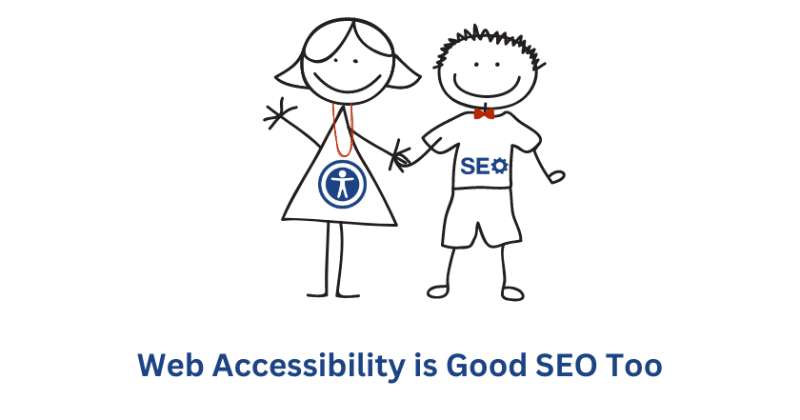Web Accessibility is Good SEO Too!

Although Google doesn’t directly consider website accessibility for its search algorithm, it does consider page experience. By making your website accessible for all users, you’ll improve their page experience and therefore, SEO.
What is Website Accessibility?
Here is a great summary of website accessibility we found on Wikipedia:
Web accessibility, or eAccessibility is the inclusive practice of ensuring there are no barriers that prevent interaction with, or access to, websites on the world wide web by people with physical disabilities, situational disabilities, and socio-economic restrictions on bandwidth and speed. When sites are correctly designed, developed and edited, more users have equal access to information and functionality.
According to the W3C, Web Accessibility Initiative, there are 4 principles of web accessibility:
- Perceivable Information and User Interface: users can access content using any one of their senses.
- Operable User Interface and Navigation: users can access the content through whatever means they choose such as a keyboard or braille keyboard.
- Understandable Information and User Interface: users must be able to read, understand and make sense of the content.
- Robust Content and Reliable Interpretation: content must be compatible with current and future tools, including assistive technologies.
Not making your website accessible could have legal consequences. Most countries require everyday products to be accessible to people who are disabled as a part of their human rights.
Various companies such as Netflix, Nike and Amazon have been sued over having non-accessible websites. Although no one has legislated this yet, we may one day have to have web accessibility statements like we do privacy statements. So, web accessibility should be implemented from a legal standpoint too. But as a marketer, making your website accessible not only will you bring positive brand vibes to the people who need accessibility the most, you’ll impact your SEO positively too!
4 Ways to Improve SEO by Making Your Website Accessible
In many ways, web accessibility and SEO already overlap. Of course, none of these suggestions involve adding a tag or code and so they will not slow down your site.
1. Create a Logical Website Structure and Pages
Just like Google’s search bots, assistive technologies leverage the website navigation, sitemaps, breadcrumbs, page titles and headings to understand content. Clear, organized and logical information helps users get to the information they want or need more easily, no matter if they’re disabled or not. But it can be especially important if that information is being relayed to you by an assistive technology device. You can also deploy a table of contents, or schema to also help assistive technology better understand your content.
2. Create Clear and Readable Content
Content that is engaging and easily read is preferred by search bots and users alike. Don’t post content to just impress the search bots, for example, keyword stuffing is often annoying to read or listen to. Voice search and assistive technologies need natural language to speak clearly. Those who read content in a second language or listen to content while distracted also appreciate simple, clear and direct writing. There’s always a real person at the end of these journeys and they need to understand what you are saying to be impressed. Websites should also use anchor text, rather than linking under a “visit here.” The anchor text explains to users, search bots and assistive technology what content is being linked to.
3. Leverage Alt Text for Images
Alt text helps search bots understand your images and it’s also a great place to include appropriate keywords. Assistive technology also consumes this information to explain to users what an image is all about. Create alt text that isn’t just a bunch of keywords but can help a user understand the image, which will make your website more usable.
4. Don’t Leave Your Video Transcripts to YouTube
YouTube and Google both depend on your video transcripts to understand what a video is all about to rank the page in search results. YouTube automatically creates a transcript from every video posted. Have you ever read one of these transcripts? I’ve seen the same word used in audio render into four different words in a transcript. It’s hard to understand people sometimes, and Google’s technology isn’t perfect. If you don’t create your own transcripts, at the very least, fix Google’s version. The people who rely on assistive technology will thank you.
At the end of the day, an accessible website will improve everybody’s experience, getting users to stay longer and use more. And nothing impresses search algorithms more than a strong user experience.
Don’t take our word for it. For our knowledge on Web Accessibility and SEO, we relied on the experts at Search Engine Journal and Search Engine Watch.
Here are some more articles we think you might enjoy reading:
- Is Your Content Unhelpful? Repent! A New Google Algorithm is at Hand
- Google Transforms Search by Putting People First
- 5 Writing Tips to Optimize for Voice Search
- Great SEO Titles & Descriptions for Better SERP Slugs
Delegate the digital marketing details to us. That’s why we’re here. Contact us today.
